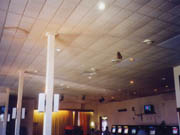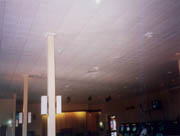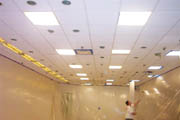

For ceiling contractors and their suppliers who, until now, have depended on new construction projects as a primary source of business, future projections suggest the need to identify other sources of business. One recent projection suggests that within the very near future, as much as 80 percent of the construction dollars will be spent on renovation of existing facilities as opposed to building new ones.
The majority of renovation projects are in occupied space where remodeling activities are limited to those hours that do not compete with normal business routines. That means nights and weekends. And so frequently, these projects do not lend themselves to replacing ceiling tiles because of either budget restrictions or time limitations. Faster, less costly alternatives are far more attractive to those working under these restrictions.
Therefore, in the future ceiling contractors who do well will be those who offer a diverse service. They will need to install new materials where required and restore old tiles when that is more appropriate. Many projects will utilize both approaches. Those contractors who insist on providing only one of these services may surely find themselves on the sidelines as the parade passes them by.

Acoustical ceiling restoration
Simply stated, ceiling restoration is not the application of a traditional paint product. The restoration of aged and/or discolored acoustical ceiling tiles involves the application of an acoustical coating that returns the surface as closely as possible to its original appearance. In some situations, a ceiling-cleaning product can be used to restore the appearance of a new tile but that is the exception to the rule. In contrast, the acoustical coating can always be depended upon to provide a consistent new appearance. Hence, it is the preferred system.Ceiling restoration is already a popular alternative to ceiling tile replacement, particularly among those multi-facility corporations that manage commercial property over a broad geographic area. Examples are national/regional retail store chains, school/university systems, national, state and local government agencies, and large commercial property management firms. From the eyes of the property owner/manager, let’s look at some of the reasons why:
• Cost: The rule of thumb is that ceiling restoration will cost one-half or less than that of new tile replacement.
• Time: Ceilings are typically restored in one-third of the time required for new tile replacement.
• Environment: Restored ceiling tiles are not discarded in landfills.
• Color: An acoustical coating can be tinted to any designer color with minimal up-charge or time delay.
• Energy: Better light reflectance means less dependency on artificial lighting.
Betty Politte, director of construction for Claire’s stores, is a strong supporter of the ceiling restoration process.
“We sat down and analyzed what it would cost us to change out the old ceiling tiles and grid, deal with sprinkle heads, bring in electricians to remove the track lights and so forth,” Politte says. “There is no question that this method, restoration vs. replacement, would cost us a lot less.”
Is the application procedure labor intensive? The labor is not as intense as it is different from new tile installation. Ceiling restoration is done in three phases: (1) area preparation, (2) spray application, and (3) discard of masking materials.
Walls, floors and furnishings are draped with thin (1-mil) plastic sheeting to protect against spray dust. Sprinkler heads, security cameras, smoke detectors and exit signs are masked off. T-bars and air diffusers are cleaned of loose soot and contamination. The ceiling is sprayed with a specialty coating manufactured specifically for this type of application. Masking materials are taken down and rolled up in the plastic sheeting in such a way as to capture loose spray dust. This material is easily deposited in the facility dumpster.
“The masking and area preparation prior to spraying the ceiling can be labor intensive unless you use the right masking technique and supplies,” says Clark Hill, of Clark’s Professional Finishes, in Portsmouth, N.H. “My product manufacturer taught me to do it the right way. It made all the difference in the world and it is reflected in additional profits.”
Select an acoustical coating for ceiling tiles
Product claims are easily made and unfortunately most coating manufacturers know little about acoustics. Therefore, it is common for salespeople to mistakenly recommend a ceiling paint and assume that it is the appropriate product. These “mistakes” lead to loss of acoustical and fire retardant properties and tiles that remain stuck to the supporting T-bar systems by a dried paint film.
To avoid such problems, the product dealers must be required to provide documentation in the form of independent laboratory test data that validates the following:
• The product does not diminish the sound absorbing qualities of the tile and preferably improves that characteristic.
• The product must be a Class-A fire retardant material.
• The product must have equal or better light reflectance ability as compared to a new ceiling tile.
• The product must have passed combustion toxicity testing which, in the case of a fire, ensures that the burning of the product will not emit an unhealthy gas.
• The product will hold its color as long as or longer than a new tile would under the same environmental conditions.
A legitimate manufacturer of special coatings should be able to readily provide such test data. Inability to do so infers that the use of that product is a gamble that should not be taken and buyer beware. The contractor’s reputation for quality work is, to a great extent, a result of the product they use. When using a product with the above five test results readily available, these become selling points in obtaining ceiling restoration business.
How profitable?
In truth, the contractor can earn more profit per square foot restoring ceilings than can be made installing new ones. What is even more impressive is that while earning that profit, the contractor is saving his or her client significant monies. Many times these savings allow for other work to be done that had been shelved due to budget constraints.
Michael Arnot, of Arnot Enterprises in Kent, Wash., says, “Since I began specializing in acoustical ceiling restoration, my profitability has improved dramatically and because I took the time to research the best products to use. The quality of our work has contributed to our reputation for excellence and our business success.”
What’s in it for a dealer? Obviously, the dealer would rather sell new tiles. But the more progressive ones recognize the segment of the market that is best satisfied by a professional ceiling restoration service. In these instances, the dealer will earn zero dollars selling only new materials but could make a sale by providing the restoration products to the contractor.
Another source of income to the dealer is through the sale of preventative maintenance products that are equally in demand. Commercial facility managers are readily receptive to aerosol products used for touching up water stains and special tools for the easy removal of loose soot around air diffusers.
A segment of the commercial property market consists of renovation projects where new tile replacement is not a desirable option. The most popular option is the restoration of the existing ceiling—a process that is cost effective and quickly installed. Ceiling restoration also avoids solid waste disposal, which is environmentally attractive.
For the ceiling contractor and supplier, ceiling restoration represents an additional source of business. Preventative maintenance products and supplies are also in demand.


Report Abusive Comment